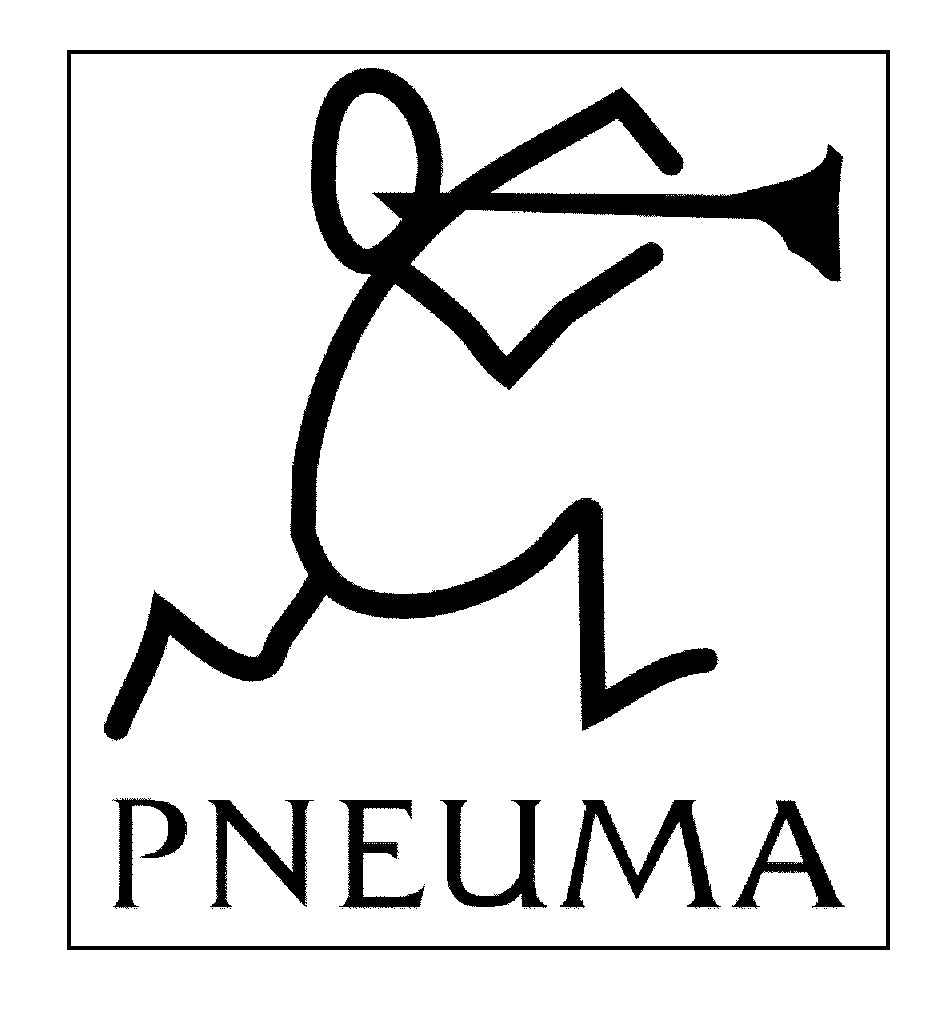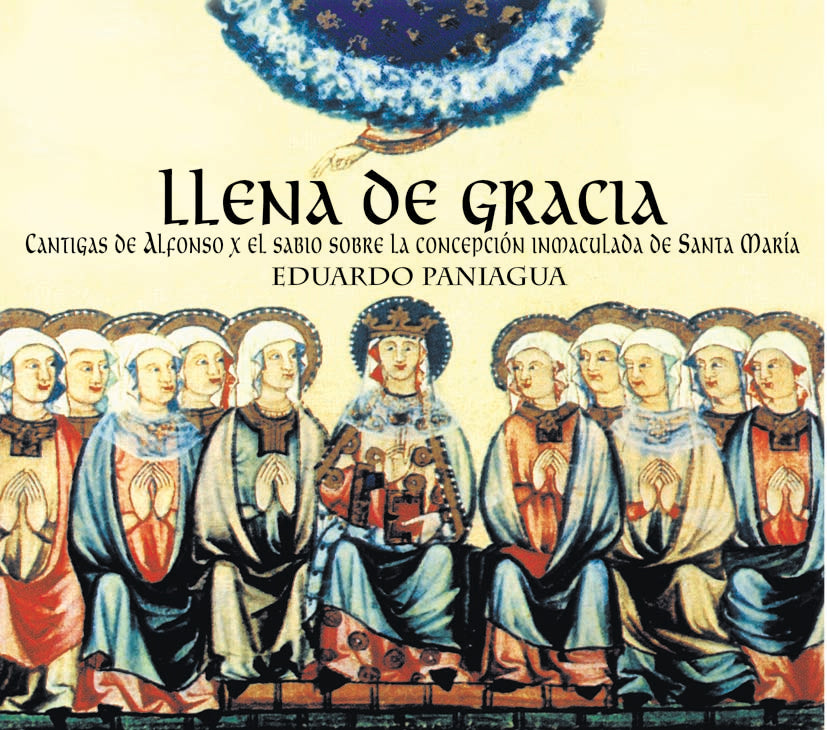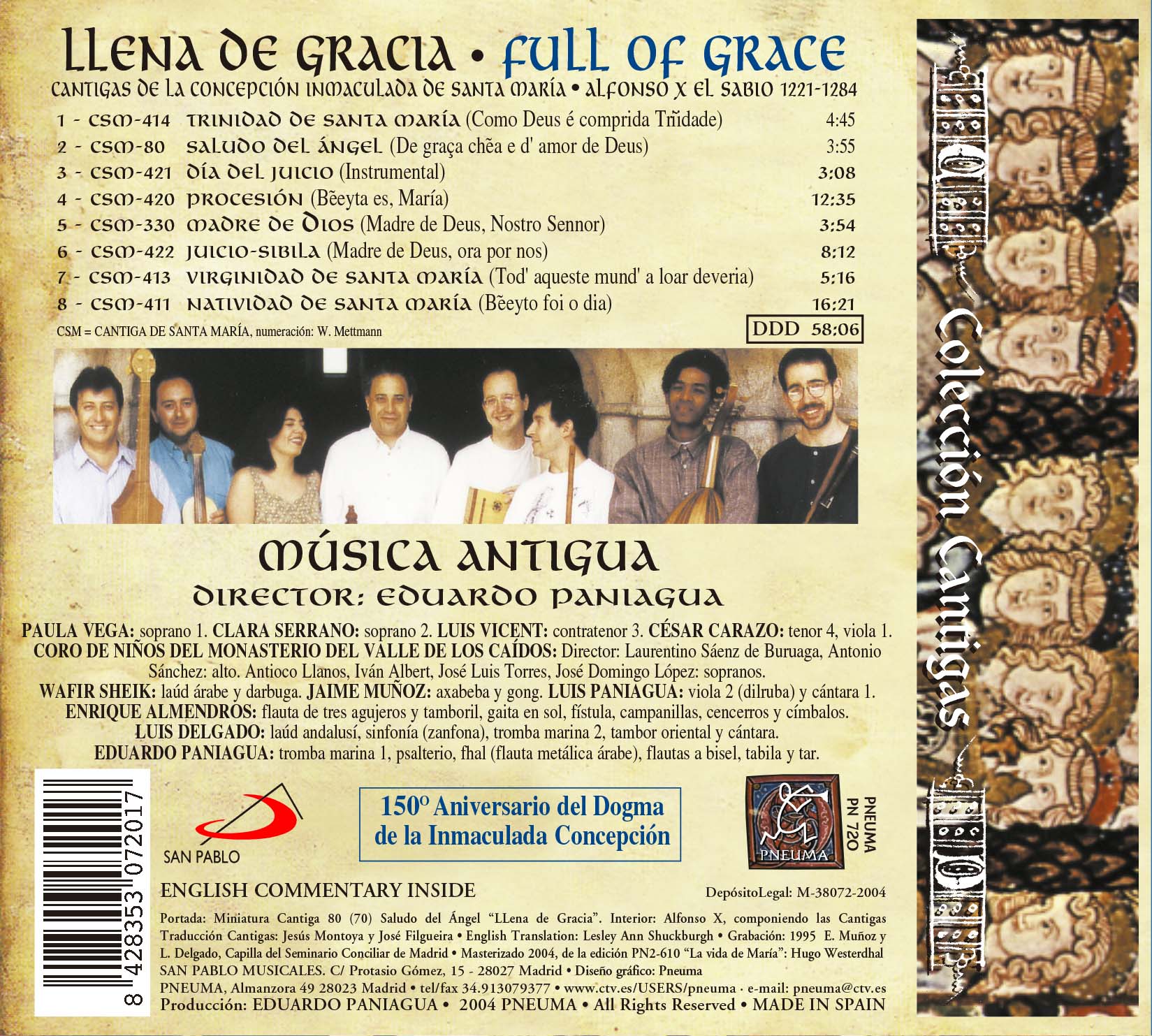pneumamusic
PN 720 LLENA DE GRACIA CANTIGAS SOBRE LA CONCEPCIÓN INMACULADA DE SANTA MARÍA
PN 720 LLENA DE GRACIA CANTIGAS SOBRE LA CONCEPCIÓN INMACULADA DE SANTA MARÍA
No se pudo cargar la disponibilidad de retiro
Índice
Índice
LLENA DE GRACIA
CANTIGAS SOBRE LA CONCEPCIÓN INMACULADA DE SANTA MARÍA.
PN-720
“Llena de gracia” es una recopilación de las Cantigas de Alfonso X el Sabio, que contienen alusiones a la inmaculada concepción de Santa María. Este CD se presenta con motivo del 150º aniversario de la proclamación del Dogma de la Inmaculada Concepción por Pío IX el 8 de diciembre de 1854 con la “Bula Ineffabilis Deus”.
La historia y significado de la concepción de María sin pecado original, en su relación privilegiada con el misterio de la salvación, al cual está asociada desde el primer momento de su existencia como “llena de gracia” y del amor de Dios, se asienta en la fe del pueblo basada en los Evangelios apócrifos que narran el encuentro de los padres de María: Joaquín y Ana. Más tarde se celebra en la fiesta de la liturgia bizantina de Santa Ana del siglo VIII.
Las Cantigas se escriben en la época del debate teológico entre los que defienden la concepción de María sin pecado original y los que afirmaban que María tenía que ser alcanzada por la redención de Cristo.
La clave se divisa en la expresión “llena de gracia” del ángel Gabriel en la Anunciación, como reflejo de María frente a la Trinidad y como colaboradora de Cristo en la redención, por lo que María es preservada del pecado original en atención de los méritos de Jesucristo en su victoria sobre el pecado y la muerte.
LAS CANTIGAS DE SANTA MARÍA
Alfonso X, hijo primogénito de Fernando III el santo y de Beatriz de Suabia, nieta del emperador Federico I Barbarroja, nació en Toledo el 22 de noviembre de 1221 y murió en Sevilla el 4 de abril de 1284. De su padre recibió valor, prudencia y religiosidad. De su madre la pasión intelectual de los Staufen y la aspiración al trono del Sacro Romano Imperio.
Como autor de las Cantigas de Santa María (CSM), Alfonso estaba inmerso en la nueva religiosidad de origen franciscano, basada en la sensibilidad y participación de la vida de la Virgen María y de Jesucristo, acentuada por el influjo bizantino del culto mariano traído al regreso de los cruzados. Como autor de la nueva ciencia astrológica, con las Cantigas sublima poéticamente en María la relación de los seres humanos y los astros.
La obra alfonsí florece en un siglo marcado por la experiencia hispano-oriental integradora de etnias y de culturas. Esta apertura, antagónica con el intolerante espíritu de las cruzadas, no renuncia a la propia identidad política ni religiosa favorable para el cristianismo, en el que el monarca se rodeaba de irremplazables auxiliares hebreos en la administración y en las ciencias, y escuchaba la música de sus mudéjares.
Las Cantigas, compuestas en la cámara regia entre los años 1270 y 1282, se conservan en cuatro manuscritos. Actualmente dos códices están en la biblioteca del Monasterio de San Lorenzo de El Escorial y dos en las bibliotecas Nacionales de Madrid y Florencia.
MARIOLOGÍA DE LAS CANTIGAS
La audición de la presente selección de Cantigas alfonsíes nos hace experimentar un verdadero encuentro personal entre el mundo y la obra del Rey sabio y nosotros en los inicios del S. XXI, por la mediación frágil de unos signos musicales escritos en un códice del siglo XIII. Es el milagro del pasado convertido en presente. Gracias a la audacia y el entusiasmo de un Rey anacrónicamente ecuménico, el alma popular en su sensibilidad íntima de piedad mariana dispersa en puntos distantes de la cuenca mediterránea, se acerca a nosotros para susurrarnos confidencialmente el sentido profundo de su fe. Más allá de la estética interpretativa y de la sintonía espiritual de estas Cantigas, podemos vislumbrar el fondo religioso y teológico que late en esta poesía musical.
Lo ""divino femenino"" en la revelación cristiana no se esfuma en la lejanía trasmítica de las diosas madres, sino que se encarna en nuestra realidad histórica concreta humana, en la que una mujer de carne y hueso, con su libertad personal, ha ofrecido a Dios su propio cuerpo para cooperar al acontecimiento irrepetible de la encarnación de Dios. De aquí brota la índole ""narrativa"" de la teología cristiana que tiene que frenar continuamente el exceso de la especulación abstracta que la amenaza.
La opción epistemológica de la mariología del Rey Sabio en sus cantigas opta por el recuento agradecido de las proezas históricas de Dios con su pueblo. No se contagia de la especulación de su tiempo elucubrando sobre los privilegios marianos, sino que, sintonizando con la incipiente teología franciscana del momento, ofrece un ramillete de narraciones, leyendas de milagros y favores que ha experimentado el pueblo sencillo. Y lo ha sabido transmitir como una herencia valiosa encarnada en sonido, en ritmo y en la luz y color de los códices miniados.
Para expresar quién es la Virgen María, las Cantigas nos comunican lo que el pueblo ha experimentado de la presencia maternal de la Señora. Es experiencia pura encarnada en arte puro. Para acercarse más a la persona de María y presentarnos un retrato teológico de la Madre de Dios, Alfonso el Sabio, además de sus milagros, nos narra en sus Cantigas los momentos cruciales de la vida de María, reflejados en sus cinco principales festividades del año litúrgico.
La audición y lectura de estas Cantigas en actitud de contemplación reposada, puede conducirnos a la elevación espiritual de toda nuestra persona. Esta elevación no será un mero ""estado de conciencia"" como alejamiento de la realidad en una mística evasiva, sino una potenciación de nuestra humanidad y la solidaridad espiritual con los hombres y mujeres en su arte, sufrimientos y alegrías. La mística de las Cantigas es ecuménica, humanística e integral. Nos eleva al mundo del espíritu y nos encarna en el mundo de la tierra. Nos humaniza y nos diviniza al mismo tiempo. Las Cantigas han sido extraídas de la tierra de los hombres y han sido regadas por el rocío del cielo.
1 - CSM 414 - Trinidad de Santa María. Se trata de una canción que nos canta la tríplice virginidad de María por analogía con la divina Trinidad. El pensamiento teológico de las Cantigas se eleva hasta las cumbres del misterio trinitario contemplando a María en su relación a las divinas personas. Hija y creatura del Padre, convertida de hija en Madre de su creador, en el Hijo por la gracia fecunda del Espíritu. Así María es la imagen ejemplar de cada miembro de la humanidad. Dice esta cantiga:
Deus buscou carne sagrada
en que nos mostrasse humanidade
comprida de todo ben...
Dios tomó carne Santa
y nos mostró una humanidad cumplida
de todo bien...
God became Holy flesh
a human form comprising all good
and nothing else...
2 - CSM 80 - Saludo del Ángel. Es una glosa del saludo de Gabriel y del de Santa Isabel, demostrando confianza ilimitada en el poder y bondad material de la Virgen, pidiendo su intercesión a favor de la humanidad.
3 - CSM 421 - Día del Juicio (Instrumental).
4 - CSM 420 - Procesión. Con estrofas sin estribillo, propias para alabanzas devocionales, la obra va profundizando en todos los motivos por los que recordar la vida de María, tomando densidad tanto musical como de profundo contenido espiritual. La procesión en la tierra se funde con las procesiones de ángeles del cielo que reciben a Santa María. Cantadas sólo cuatro de sus estrofas, en la primera se dice:
B˜eeyta es, María, Filla, Madr’ e criada
de Deus, teu Padr’ e Fillo, est’ é cousa provada.
B˜eeyta foi a ora en que tu g˜eerada
fuste e a ta lama de Deus santivigada,
e b˜eeyto o dia en que pois fuste nada
e d’Adam o peccado quita e perdõada.
Bendita eres, María, Hija, Madre y criada
de Dios, tu Padre e Hijo, esto es cosa bien probada.
Bendita fue la hora en que engendrada fuiste
y santificada por Dios tu alma,
y en bendito (el día) en que naciste
y exenta y perdonada del pecado de Adán.
Blessed are you Mary, Daughter, Mother and servant
of God, your Father and Son,this is beyond a doubt.
Blessed was the hour when you were conceived
and your soul was sanctified by God,
and blessed was the day you were born
exempt and pardoned of Adam's sin.
5 - CSM 330 - Madre de Dios. Esta canción trata del saludo de Gabriel anunciando a María que sería la Madre de nuestro Señor. Cada estrofa propone un enigma cuya solución está en el estribillo. En la primera estrofa se dice:
Qual é a santivigada
ant´ e depois que foi nada?
Madre de Deus, Nostro Sennor,
de Deus, Nostro Sennor,
e Madre de nosso Salvador.
¿Quién fue la santificada
antes y después que naciera?
La Madre de Dios, nuestro Señor,
de Dios, nuestro Señor
y Madre de nuestro Salvador.
Who was sanctified
before and after She was born?
The Mother of God, our Lord,
of God, our Lord
and Mother of our Saviour.
6- CSM 422 - Juicio-Sibila. Balada en la que, al cantar la plegaria a la Virgen a fin de que interceda por nosotros en el día del Juicio, Alfonso X y sus trovadores utilizaron el célebre Ave Maris stella, conocido en Europa desde el siglo IX.
7 - CSM 413 - Virginidad de Santa María. Se celebraba en el mes de diciembre y fue propaga en Occidente en el curso del siglo XII. Llama curiosamente la atención la Virginidad de María, entendida como la pureza integral de su vida y persona. Es la consagración personal incondicional de la ""esclava del Señor"" que significa mucho más que la virginidad ritual de las religiones paganas. Es la ""gratia plena"", la enriquecida con la plenitud de gracia, como don gratuito de Dios y fruto anticipado de la redención de su Hijo.
8 - CSM 411 - Natividad de Santa María. Se celebra el 8 de septiembre y en treinta estrofas narra la historia de los padres de la Virgen, Joaquín y Ana, basándose en el protoevangelio de Santiago, ya que los Evangelistas no hablan del linaje de María. Con forma de virelai, la frase musical del final del refrán se repite cuatro veces en las estrofas de un modo obstinado y repetitivo. Ello hace que el resto de la melodía, de un gran recorrido en su tesitura y con un complejo ritmo interior, salte luminosa sin fatigar la escucha. No obstante, se han introducido recitados en los momentos en los que hablan Joaquín y el ángel, así como una instrumentación rica para suavizar lo extenso de la emocionante narración del nacimiento de María. El Rey Sabio en esta Cantiga es testigo de la teología popular que más tarde elevaría a rango académico universal Escoto y los franciscanos sobre la Inmaculada Concepción de María en el seno de su madre Santa Ana. Momento de polémica teológica entre franciscanos y dominicos; Buenaventura y Tomás de Aquino. Dice la Cantiga:
E logo que foi viva / no corpo de sa madre
foi quita do pecado / que Adan, nosso padre,
fezera per consello / daquel que, pero ladre
por nos levar consigo, / a porta ll'é serrada do inferno.
Y luego que estuvo viva en el cuerpo de su madre,
fue exenta del pecado que Adán, nuestro padre,
cometiera por consejo de aquél que, aunque ladre
para llevarnos consigo, la puerta del infierno le fue cerrada.
And then when She was alive in the body of her mother,
She was free of the sin that Adam, our father,
committed incited by the one who barks
in vain to take us with him, as the gate of hell was closed to him.
Basado en los evangelios apócrifos, el ángel anuncia el nacimiento de María a sus padres Ana y Joaquín por separado:
...qui Deus que do seu angeo foss’ ela confortada.
E disse-lle: “Non temas, Anna, ca Deus oyda
a ta oraçon ouve; e poren sen falida
de teu marido filla averás, que comprida
será de todos b˜ees mais d’outra e preçada.”
...quiso Dios que fuese confortada por su ángel.
Y le dijo: ""No temas, Ana, pues Dios ha oído
tu oración; y por tanto sin falta
tendrás una hija de tu marido, que llena será
de todo bien y apreciada más que cualquier otra.
...and God wanted her to be comforted by his angel.
And the angel said, ""Do not be afraid,Anne,God
has heard your prayer; and so you will
have a daughter by your husband, and She will
be good and loved more than any other.""
--------
O angeo lle disse: “Eu soon mandadeiro
a ti de Deus do çeo por te fazer certeiro
que de ta moller Anna averás tal erdeiro
por que toda a terra será enl˜umeada.
E se esto que digo t˜ees por maravilla,
certãamente cree que te dará Deus filla,
que o que perdeu Eva per ssa gran pecadilla
cobrar-ss-á per aquesta, que será avogada.
Entre Deus e as gentes que foren pecadores.
El ángel le dijo (a Joaquín): ""Yo soy el mandadero
del Dios del cielo hacia ti para hacerte cierto
que de tu mujer Ana tendrás tal heredero
por quien será iluminada toda la tierra.
Y si tienes esto que te digo como maravilla,
con toda certeza que Dios te dará una hija.
Y lo que perdió Eva, para su gran pesadilla,
lo cobrará ésta, quien será abogada
entre Dios y las gentes que hubieran sido pecadores.
------
The angel said, ""I am the messenger
of God sent from heaven to tell you
that your wife Anne will give you an heir
who will illuminate the whole earth.
And if this seems too good to be true,
it will be so and God will give you a daughter.
And what Eve lost, to her great shame,
this one will gain, and will be an advocate
of God and the people who would otherwise
have been sinners.
Francisco Caballero y Eduardo Paniagua
Descripción
Descripción
FULL OF GRACE
“Full of Grace” is a compilation of those Cantigas de Alfonso X el Sabio that contain allusions to the Immaculate Conception of the Virgin Mary. This CD has been launched to mark the 150th anniversary of the Papal Bull “Ineffabilis Deus”, issued by Pius IX on the Immaculate Conception on 8th December 1854.
The conception of the Virgin Mary is believed to be exempt from the stain of original sin as part of her privileged relationship with the mystery of salvation, to which she is associated from the first moment of her existence, being “full of grace” and the love of God. This idea and its meaning are firmly rooted in the faith of the people based on the texts in the Apocryphal Gospels, which tell the story of Mary’s parents, Joachim and Anne. It is later celebrated by the feast of St. Anne in the Byzantine liturgy in the 8th century.
The Cantigas were written at the time of the theological debate between those who defended the conception of Mary without original sin and those who affirmed that Mary had to be redeemed by Christ.
The key can be discerned in the expression “full of grace” pronounced by the angel Gabriel in the Annunciation. Mary is thus elevated to the heights of the Trinity and a collaborator of Christ in the redemption. She is exempt from original sin in view of the merits of Jesus Christ in his victory over sin and death.
THE CANTIGAS OF HOLY MARY
Alfonso X, eldest son of Fernando III the Saint and of Beatrice of Swabia, granddaughter of the emperor Frederick I Redbeard, was born in Toledo on 22 November 1221 and died in Seville 4th April 1284. From his father he inherited courage, prudence and religiousness. From his mother the intellectual passion of the Hohenstaufen and the aspiration to the throne of the Holy Roman Empire.
As the author of the Cantigas de Santa María (CSM), Alfonso was immersed in the new religious ideas of the Franciscans, based on a sensitivity towards and interest in the life of the Virgin Mary and Jesus Christ. These ideas were reinforced by those returning from the Crusades bringing back a stronger belief in the Marian cult, influenced by Byzantine thought. Alfonso, author of the new science of the stars, presents Mary as the sublime link between the stars and the human race in his poetry.
Alfonso's work blossoms in a century remembered for the integration of Spanish and Oriental ethnic groups and cultures. This open-mindedness, in contrast to the intolerant spirit of the Crusades, does not renounce a political or religious identity that was favourable to Christianity. At the same time however, the monarch surrounded himself with irreplaceable Hebrew auxiliaries in his administration and in the sciences, and listened to the music of his Mudejars.
The Cantigas, composed in the royal chamber between 1270 and 1282, are preserved in four manuscripts. Two codices are now in the library at the Monastery of San Lorenzo in El Escorial and two are in the National Libraries in Madrid and Florence.
THE MARIOLOGY OF THE CANTIGAS
This selection of Cantigas brings the opportunity to experience a truly personal encounter with the work of the Wise King. Through the fragile mediation of some symbols written in a codex in the 13th century his world meets ours at the beginning of the 21st century. It is the miracle of the past converted into the present. Thanks to the audacity and the enthusiasm of a King who was anachronically ecumenical, the soul of a people with its intimate feeling of devotion to Mary, approaches us to whisper the secret of the depth of its faith, from distant places scattered around the Mediterranean. Beyond the artistic quality of the performance and the spiritual element in these Cantigas, we can explore the religious and theological depths that beat in the heart of this musical poetry.
The ""feminine divinity"" in Christian revelation does not lurk in the distant world of the myth of the mother goddesses. It manifests itself in our own human historical reality, in which a woman of flesh and blood, with her own personal liberty, offered God her body to participate in the unrepeatable event of His Incarnation. The ""narrative"" aspect of Christian theology stems from this human characteristic and has to continually ward off the excess of abstract speculation that threatens it.
The Wise King’s epistemological approach can be appreciated in the Cantigas as he develops his Mariology through stories told with gratitude for God's historic acts of prowess with his people. He does not allow himself to be affected by the speculation abounding at the time that pondered the Marian privileges. Instead he goes along with the budding contemporary Franciscan theology and produces a collection of stories and legends of miracles and favours that ordinary people had experienced. And he knew how to transmit this as a valuable legacy expressed in sound, in rhythm and in the light and colours of the illustrated codices.
To tell us who the Virgin Mary is the Cantigas relate the people's experiences of the maternal presence of Our Lady. A pure experience embodied in pure art. To get closer to Mary the person and present a theological portrait of the Mother of God, Alfonso the Wise gives an account of the most important moments in Mary's life in his Cantigas, whilst reminding us of the way they are reflected in her five main feasts in the liturgical year.
If we listen to these Cantigas and read the texts in a relaxed and contemplative atmosphere, we might find our spirits being uplifted. This elevation will not be a mere ""state of consciousness"" as an escape from reality in an ""evasive mysticism"", but a reinforcement of our human condition and spiritual solidarity with men and women in their art, sufferings and pleasures. The mysticism of the Cantigas is ecumenical, humanistic and integral. It lifts us up to the spiritual world and embodies us in the terrestrial world. A mysticism that humanizes us and deifies us at the same time.
The Cantigas have been extracted from the earth of men and watered by the dew of heaven.
1 – CSM 414 – TheTrinity of Holy Mary.
This song is about the triple virginity of Mary by analogy with the divine Trinity. Theological thought in the Cantigas reaches the heights of the mystery of the Trinity and contemplates Mary in her relationship to divine figures. Daughter and creation of the Father, converted from daughter into mother of her creator. The creator converted in turn into Son through the fertile grace of the Holy Spirit Thus Mary is the exemplary image of each member of the human family. This cantiga says:
2 – CSM 80 – The Angel’s greeting. This is a glosa about the angel Gabriel’s greeting as well as St. Elizabeth’s greeting and demonstrates limitless confidence in the power and material kindness of the Virgin, asking her to intercede in favour of humanity.
3 – CSM 421 – Day of Judgment (Instrumental).
4 – CSM 420 – Procession. This piece examines all the reasons for remembering the life of Mary and the content is both musically dense and spiritually profound. The strophes without a refrain are suitable for devotional praises. The procession on earth blends with the processions of angels in heaven who receive Holy Mary. Only four of its strophes are sung, and the first says:
5 – CSM 330 – Mother of God. This song is about the angel Gabriel’s greeting telling Mary that she would be the Mother of our Lord. Each strophe proposes an enigma and the solution is in the refrain. The first verse says:
6- CSM 422 – Judgment-Sybil. A ballad in which a prayer is sung to the Virgin asking for her help on the day of Judgment. Alfonso X and his troubadours use the famous Ave Maris stella, well known in Europe since the 9th century.
7 – CSM 413 – The Virginity of Holy Mary. The Virginity of Holy Mary is celebrated in the month of December and the feast day spread in the West during the 12th century.
It is interesting to note that the virginity of Mary was taken as the essence of the purity of her life and her person. It represents the unconditional personal consecration of the ""slave of the Lord"" which means much more than the ritual virginity of the pagan religions. Her virginity is the ""gratia plena"", the epitome of grace, as a free gift from God and anticipated fruit of the redemption of her Son.
8 – CSM 411 – The Birth of the Virgin Mary. This is celebrated on the 8th September and in thirty verses this cantiga tells the story of the parents of the Virgin, Joachim and Anne, based on the Protevangelium of James. The Evangelists do not speak of the lineage of Mary. In the form of a virelay, the musical phrase at the end of the refrain is repeated four times in the verses in an obstinate and repetitive way. This adds interest to the rest of the melody, which, in spite of its ample range and complex rhythm, is not tiring to listen to. However, recitations have been introduced when Joachim and the angel speak, as well as a rich use of instruments to make the long emotive story of the birth of Mary easier on the ear. In this Cantiga the Wise King is witness to the popular theology that John Duns Scotus later took to universal academic rank, and to Franciscan views on the Immaculate Conception of Mary in the breast of her Mother St. Anne. A moment of theological controversy between Franciscans and Dominicans, Buenaventura and Thomas Aquinas. The Cantiga says:
Based on the Apocryphal Gospels, the angel announces the birth of Mary to her parents, Anne and Joachim, separately:
Francisco Caballero y Eduardo Paniagua
Compartir
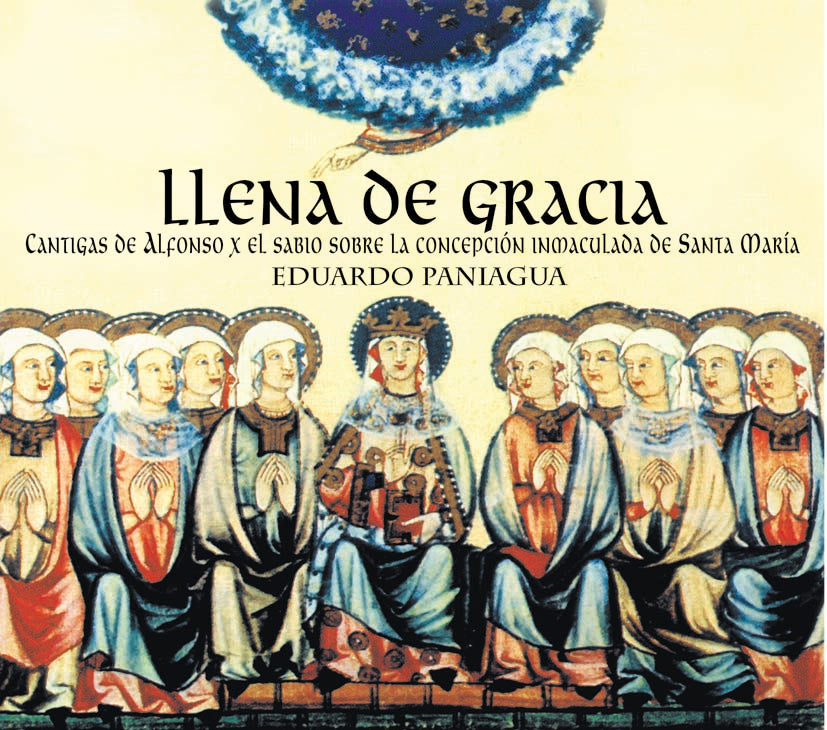
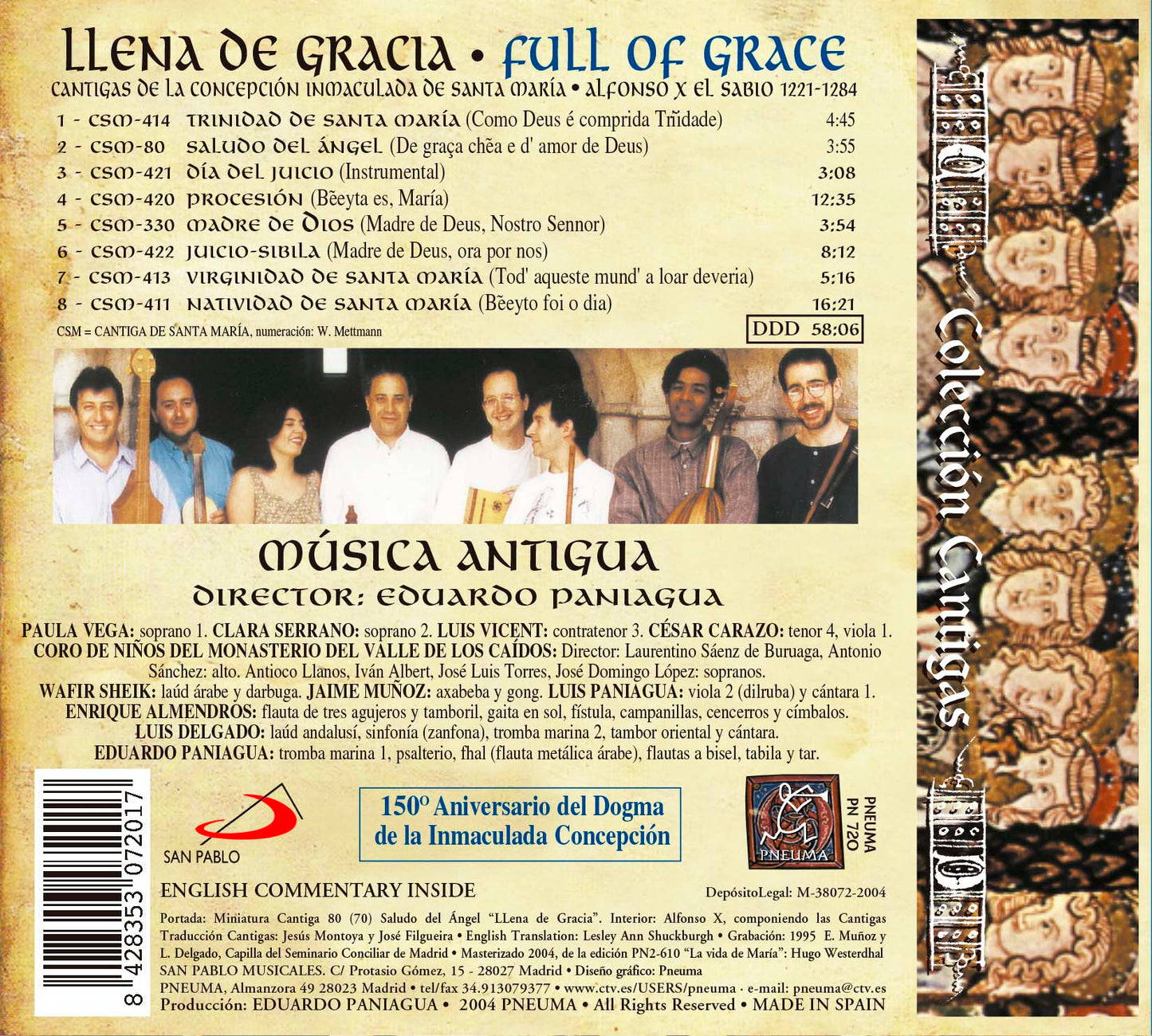
-
Envío gratis en pedidos mayores a 50 €.
Entrega en 5-7 días laborables para pedidos en España, en el caso de envíos fuera de España el tiempo de envío podría ser algo mayor.
-
Todo el trabajo de Pneuma Music se ha realizado en España.
Música medieval española inédita hasta el momento. Sus discos, con formato Digipack de cubierta de cartón y libreto interior (bilingüe + idioma original), quieren acercarse a una obra de arte total.
